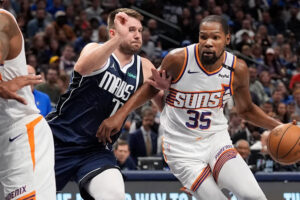It was early October and the NFL had a problem. It wasn’t just that Tennessee Titans players and staff continued to test positive for Covid-19, in an outbreak that rocked the American Football League season. And it wasn’t even that the league was realizing that the virus could get through the holes in their protocols.
The NFL was slowly uncovering something much deeper: A foundational tenet of Covid-19 transmission wisdom, how to define when people are in “close contact,” was simply wrong.
The safety of interactions during this global pandemic had been measured for months with a stopwatch and tape. The guideline was that someone had been exposed to the virus if they had been within two meters of an infected person for more than 15 minutes. It was instilled in everyone for so long that it became the gospel of the coronavirus.
But that turned out not to be true during the NFL outbreaks. People tested positive for the virus even though they had spent much less than 15 minutes or were not within six feet of an infected person, and the league had the contact tracing technology to prove it.
“That was a wake-up call,” said Dr. Allen Sills, the NFL’s chief medical officer. “We had to be more precise in our definition of high-risk close contacts because clearly transmission could occur outside of those basic limits of time and distance.”
The finding of the league is the fundamental reason why the NFL managed to fulfill its entire regular season, playing all 256 games, and arrived as scheduled until the Super Bowl, which is played this Sunday between the Tampa Bay Buccaneers and the Kansas City Chiefs.
Foto: Associated Press
In the days, weeks and months after the Titans outbreak, the NFL changed its rules to further reduce close contacts. Thus, it was stipulated that people would be considered as exposed to the virus if they had had interactions without a mask in closed spaces with an infected person, regardless of the length of time of that contact. And it introduced longer quarantine periods for exposed people, preventing them from spreading the virus further.
Those findings have now been presented in a document, written by several doctors who worked with the NFL and the NFL Players Association (NFLPA), and published by the United States Center for Disease Control (CDC), which opens a new window to the numbers that changed this thinking.
“This has implications far beyond the NFL,” said Dr. Thom Mayer, the NFLPA’s chief medical officer. “This is more transmittable than people thought.”
Sports leagues, in their extreme motivation to play during a pandemic, have generated an unrivaled trove of data and case studies on how the virus is and is not transmitted. No other organization has had large groups of the same people doing a variety of activities together, for weeks, while also spending millions of dollars to track their movements and test them daily with quick results.
The NFL, the richest league in the country with thousands of employees across the country, was the clearest case of this. The league, in essence, had snapshots of 32 communities across the United States, since that’s the number of Euppes that make it up. From Aug. 1 to Jan. 23, he tested 954,830 more than 7,000 people per week during the regular season, and confirmed 724 positive cases.
The league passed hundreds of thousands of those tests before its first major problem emerged. On September 29, eight members of the Tennessee Titans received positive results on the same day. Over the next few days, more than 20 Titans players and staff would test positive.
Rules requiring the use of masks inside the facilities, social distancing and device-based contact tracing had not prevented the outbreak, the league learned. The almost daily test did not intercept or stop the outbreak in its tracks, because the appropriate people had not been identified as exposed and quarantined.
From September 27 to October 10, there were a total of 41 cases in the league. Of these, 21 were believed to have come from transmission within an individual team, a finding driven by genomic sequencing.
Those 21 cases yielded fascinating insights. Twelve had no close interactions of at least 15 consecutive minutes with a confirmed positive. Eight had no interactions of even five consecutive minutes. And seven had no interactions that cumulatively totaled 15 minutes with confirmed positives.
Right at the same time as the Titans outbreak in October, a similar lesson came from a prison in Vermont, another US state. An investigation there confirmed that brief cumulative interactions exceeding 15 minutes could lead to streaming. It didn’t have to be 15 consecutive minutes, prompting the CDC to change its definition of close contact to a cumulative 15 minutes over the course of 24 hours.
But it was the NFL that had enough data to indicate something even bigger. There were still those seven cases where even cumulative interactions lasted less than 15 minutes and the virus was still being transmitted.
Nor was it simply the amount of time. It was also the distance. The virus, in some cases, traveled more than two meters, especially in small, poorly ventilated areas. And the masks, more than the duration of contact, seemed to matter a lot.
Thereafter, the NFL distanced itself from the principle of “less than two meters for more than 15 minutes” as its official stance as an exposure rule. Those who were exposed had to spend five days testing negative and in isolation to be able to return.
“We had to adapt and change our approaches,” said Jeff Miller, the NFL’s executive vice president who oversees health and safety at the organization.
 Foto: Getty Images
Foto: Getty Images
The league introduced strict new rules for any team with a single positive. He began testing seven days a week, instead of six. More critically, he refocused his contact tracking to consider context, something that motion traceability devices couldn’t detect. An encounter with masks outdoors could be treated differently than a ride in a shared car without masks, for example.
The NFL told teams to hold meetings virtually, avoid indoor encounters, even if they were far apart, and stop eating together. If someone had done any of these things with a person who subsequently tested positive they had to be isolated immediately, regardless of how brief their interaction had been.
“It goes back to those four basic things we talked about in the newspaper: accumulated time, distance, ventilation and masks. If you think of those four factors as four different quadrants, if you’re failing in two or more of them, that will turn into a high transmission risk, ”Sills said. “I always talked about the big three (risks), which were: meet, eat and say hello.”
While NFL virus rates increased the most during the second half of the season – a reflection of the growing number of cases in the United States – the data in the CDC document indicates how much worse it could have been if it weren’t for these. changes. From October 15 to November 11, 20 people who were identified as high-risk close contacts ended up testing positive for Covid-19. That means they had already been isolated before they could transmit the virus to anyone else on their computers. And had that protective measure not been taken, those 20 cases could have created many more.
The intensive protocols the NFL implemented in October, for any team that had a positive case, also significantly reduced close contacts. Teams under those restrictions saw their average interactions from six feet away for at least 15 minutes decrease by 60%. And even the number of interactions that lasted two minutes was reduced by 28%.
Later, the NFL converted the intensive protocols into the new standard protocols. And they managed to last all the way to the Super Bowl.











